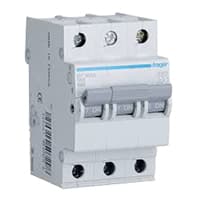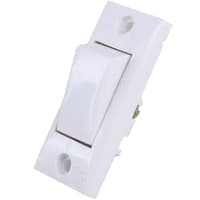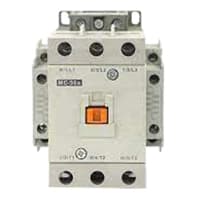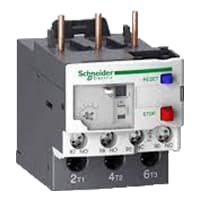Timer contactor wiring diagram:
This diagram shows a Timer contactor wiring diagram. In this circuit, we use a TP MCB ( Tripple Pole Miniature Circuit Breaker ), a timer, an SPST Switch, a magnetic contactor, and an overload relay. First, we need to connect the TP MCB with the power source, then connect the timer with TP MCB, then connect the SPST Switch the timer, then connect the magnetic contactor with the timer and then connect the overload. Now this circuit is ready for use.
Advertisements
Components needed For this Project:
You can get the components from any of the sites below:
- TP MCB 20A [See Buy Click Amazon]
- Digital Timer 220V AC [See Buy Click Amazon]
- SPST Switch [See Buy Click Amazon]
- Magnetic Contactor 40A [See Buy Click Amazon]
- Motor Protector Overload [See Buy Click Amazon]
*Please note: These are affiliate links. I may make a commission if you buy the components through these links. I would appreciate your support in this way!
Advertisements
Components used to make the Timer contactor wiring:
The full meaning of MCB is Miniature Circuit Breaker for TP MCB. MCB is an electromagnetic switch or device. If for any reason a short circuit occurs in the supply line or load line (line to line or line to neutral) or in case of overload MCB. the MCB automatically trips and disconnects the main line circuit or household power supply Connection. TP MCB In 3 Pole MCB, Switching & Protection is affected in only 3-Phases and the Neutral is not part of the MCB. 3 pole MCB signifies the Connection of Three Wires for a 3-Phase system Red-Yellow-Blue Phase. 3-Phase Supply Only Without Neutral.
02. Timer:
A timer is a type of time-switching device that controls and controls Electrical circuits and electrical and electronic devices through time setting (on/off). The timer is basically 8-pin. Like other controlling devices the timer has a coil and when this coil is magnetized, the timer works on/off. The timer has 2 common ends and each common end has normally close and normally open options. When the timer is set by time, the timer trips at the end of that time and turns the common is normally closed (on) to open (off) and normally open (off) to close (on). This is how the timer works.
An SPST (Single Pole Single Throw) Switch is a Switch That only Has a Single Input and can Connect Only to one Output. This means it Only Has one Input Terminal and Only 1 Output Terminal. A Switch is a Mechanical or Controlling Device That Changes the Flow of Current Direction or Interrupts the Flow of Current Within a Circuit diagram. An electrical line using Single Pole Single Throws (SPST) is Perfect for on-off switching. When the SPST is closed, the Circuit is Closed and the light from the lamp switches on the system. When The Single Pole Single Throw (SPST) is then opened, the light from the lamp goes out and the Circuit is off.
04. Magnetic Contactor:
A magnetic contactor is an electromagnetic switching device. It is generally used for controlling 3-phase Motors. The operation of a magnetic contactor is similar to that of a Relay. but a relay is used for low-power or low-voltage connections, and a magnetic contactor is used for high-power or high-voltage connections. As soon as the supply is applied to the magnetic contactor coil. its normally open contacts are closed and normally closed contacts are opened and the associated devices are also operated. This is how a magnetic contactor works.
Overload Protection is Protection Against a Running Overcurrent That Would Cause Overheating of The Protected Equipment. Hence, An Overload is Also a Type of Overcurrent flow. Overload Protection Typically Operates on an Inverse Time curve where the Tripping Time Becomes less as the Current Increases. This Overload Protector is an Essential Component for Many Sockets Power Systems. The Top-Quality Overload Protector can Effectively Protect Electrical Products from Power Surges.
Thank You for visiting the website. Keep visiting for more Updates.
Frequently asked questions
On the front of the contactor, you'll see 2- wire terminals A1 and A2. This is where we could connect a 24-volt DC power to the coil to energize it. The A1 wire terminal is where the 24V DC positive signal wire gets connected and the A2 wire terminal is where the 24v DC negative signal wire gets connected.
A contactor is typically controlled by a circuit diagram that has a much lower power level than the switched circuit, such as a 24-volt coil electromagnet controlling a 230-volt motor of the switch. Unlike general-purpose relays, contactors are designed to be directly connected to high-current supply load devices.
Generally no, just like light switches. However, sometimes if the contactor is in a system that is served from multiple sources, say a battery and AC power supply, an extra wire would be desired, even if not absolutely required, for system separation.
Ensure the ambient temperature around the contactor is maintained within specified levels or avoid any hot spots, as contactors are generally energized for very long periods of time.
That makes them especially useful when there is a need for high amperage or voltage protection on circuit diagram breakers and switches. Main operating contacts are used to control the operation of motor-operated equipment such as switches, circuit diagram breakers, and contactors.
Read more Single Phase Wiring
What is a kilowatt-hour (kWh) | kwh formula | What does kwh mean
Introduction to Electrical Units and CircuitskW and kWh on your electricity bill As your home uses electricity during...
What is the Difference Between kVA | What does KVA mean | kVA formula
Difference Between KVA ExplainedWhat does KVA Mean? There are technical terms aplenty when it comes to generators, and...
Power Factor | Power Unit | Energy | Electricity Unit
Power factor definition | Calculating Power FactorPower Factor Values In a purely resistive circuit, the power factor...






0 Comments